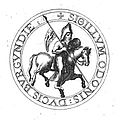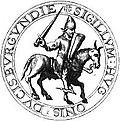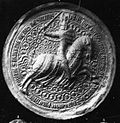Top Qs
Timeline
Chat
Perspective
Duke of Burgundy
Title used by the rulers of the Duchy of Burgundy From Wikipedia, the free encyclopedia
Remove ads
Duke of Burgundy (French: duc de Bourgogne) was a title used by the rulers of the Duchy of Burgundy, from its establishment in 843 to its annexation by the French crown in 1477, and later by members of the House of Habsburg, including Holy Roman Emperors and kings of Spain, who claimed Burgundy proper and ruled the Burgundian Netherlands.[1]
The Duchy of Burgundy was a small portion of the traditional lands of the Burgundians west of the river Saône which, in 843, was allotted to Charles the Bald's kingdom of the West Franks. Under the Ancien Régime, the duke of Burgundy was the premier lay peer of the Kingdom of France. Beginning with Robert II of France (r. 996–1031), the title was held by the Capetians, the French royal family. In 1032 King Henry I of France granted the duchy to his younger brother, Robert, who founded the House of Burgundy. When the senior line of the House of Burgundy became extinct in 1361, the title was inherited by King John II of France through proximity of blood. John granted the duchy to his younger son, Philip the Bold, in 1363. The Valois dukes gradually came to rule over a vast complex of territories known as the Burgundian State, and became dangerous rivals to the senior French royal line of the House of Valois.
When the male line of the Valois dukes of Burgundy became extinct in 1477, the Duchy of Burgundy was confiscated by Louis XI of France. The title "duke of Burgundy" passed to Habsburg monarchs after Mary of Burgundy married Maximilian I of Austria in 1477. The Habsburgs used this connection to claim Burgundy proper and to rule their Burgundian inheritance until the Napoleonic era. The title was subsequently revived for several younger sons of the House of Bourbon and since 1975, branches of it have used "duke of Burgundy" as a revived courtesy title.
Remove ads
List of dukes of Burgundy
Summarize
Perspective
Bosonid dynasty (880–956)
The first margrave (marchio), later duke (dux), of Burgundy was Richard of the House of Ardennes,[citation needed] whose duchy was created from the merging of several regional counties of the kingdom of Provence which had belonged to his brother Boso. Richard was the son of Eccard of Macon and Richildis of Arles, Boso the son of Bivin of Gorze and Richildis of Arles.
His descendants and their relatives by marriage ruled the duchy until its annexation over a century later by the French crown, their suzerain.
- Richard the Justiciar (880–921)
- Rudolph (921–923), then King of the Franks
- Hugh the Black (923–952)
- Gilbert (952–956)
Robertian dynasty (956–1002)
- Otto (956–965)
- Eudes Henry the Great (965–1002)
House of Ivrea (1002–1004)
- Otto William (1002–1004)
House of Capet (1004–1032)
In 1004, Burgundy was annexed by the king, of the House of Capet. Otto William continued to rule what would come to be called the Free County of Burgundy. His descendants formed another House of Ivrea.
House of Burgundy (1032–1361)
Robert, son of Robert II of France, received the Duchy as a peace settlement, having disputed the succession to the throne of France with his brother Henry.
House of Valois-Burgundy (1361–1482)
On 28 December 1361 John II of France, the second Valois king, successfully claimed the duchy after the death of Philip, the last Capet duke.[2] The duchy did not merge into the royal domain; it remained a distinct feudal entity, with the Burgundian estates firmly opposing annexation.[2][3]
In January 1362 he had appointed Henri of Bar, Lord of Pierrefort, as the initial governor[4], but As early as January 25, 1362, John appointed John of Melun, Count of Tancarville as govenor of Burgundy.[5]
John then passed the duchy to his youngest son Philip as an apanage in 1363.
Family tree

House of Habsburg (1482–1700)
In 1477, the territory of the Duchy of Burgundy was annexed by France. In the same year, Mary married Maximilian, Archduke of Austria, giving the Habsburgs control of the remainder of the Burgundian Inheritance.
Although the territory of the Duchy of Burgundy itself remained in the hands of France, the Habsburgs remained in control of the title of Duke of Burgundy and the other parts of the Burgundian inheritance, notably the Low Countries and the Free County of Burgundy in the Holy Roman Empire as well as the County of Charolais in France. They often used the term Burgundy to refer to it (e.g. in the name of the Imperial Circle it was grouped into), until the late 18th century, when the Austrian Netherlands were lost to the French Republic. The Habsburgs also continued to claim Burgundy proper until the Treaty of Cambrai in 1529, when they surrendered their claim in exchange for French recognition of Imperial sovereignty over Flanders and Artois.
- Maximilian I (1477–1482 with his wife; regent 1482–1494)
- Philip IV the Handsome (German: Philipp der Schöne; French: Philippe le Beau), titular Duke of Burgundy as Philip IV (1482–1506)
- Charles II (Holy Roman Emperor Charles V and King Charles I of Spain) 1506–1555
- Philip V (King Philip II of Spain) 1556–1598
- Isabella I (infanta Isabella Clara of Spain) and Albert I (Albert VII of Austria) (jure uxoris) 1598–1621
- Philip VI (King Philip IV of Spain) 1621–1665
- Charles III (King Charles II of Spain) 1665–1700
House of Bourbon, claimants of the title (1682–1761)
House of Habsburg (1713–1918)
- Charles IV (Emperor Charles VI) 1713–1740
- Maria Theresa 1740–1780
- Joseph (Emperor Joseph II) 1780–1790
- Leopold (Emperor Leopold II) 1790–1792
- Francis (Emperor Francis II) 1792–1795/1835
- Ferdinand (Emperor Ferdinand I) (1835–1848 titular only)
- Franz Joseph (Emperor Franz Joseph I) (1848–1916 titular only)
- Charles V (Emperor Charles I) (1916–1918 titular only later renounced)
House of Bourbon, revived title (1975–present)
- King Juan Carlos I of Spain (1975–2014)
- King Felipe VI of Spain (2014–present) – the title is one of the titles of the Spanish Crown
- Prince Sixtus Henry of Bourbon-Parma (Carlist claimant to the throne of Spain as "Enrique V", 1977–present) – the title is one of the titles of the Spanish Crown. He is considered the legitimate successor to the Catholic Monarchy of the Spains as heir to Infante Carlos María Isidro ("Carlos V").
- Louis, Dauphin of France (2010–present) – the title is used by eldest son of the Legitimist claimant to the French throne, Prince Louis, Duke of Anjou ("Louis XX").
Remove ads
See also
References
Further reading
Wikiwand - on
Seamless Wikipedia browsing. On steroids.
Remove ads


























